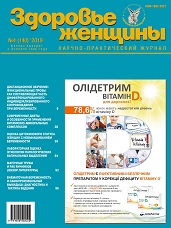Лабораторна оцінка етіології патологічних вагінальних виділень
DOI:
https://doi.org/10.15574/HW.2019.140.64Ключові слова:
патологічні вагінальні виділення, вагінальна мікробіота, вульвовагінальний кандидоз, бактеріальний вагіноз, аеробний вагініт, цитолітичний вагінозАнотація
Патологічні вагінальні виділення (ПВВ) є однією з найпоширеніших скарг у жінок різного віку. Сьогодні гінекологи все частіше стикаються з проблемою, коли за відсутності лабораторного підтвердження вульвовагінального кандидозу, бактеріального вагінозу та ІПСШ жінки пред’являють скарги на дискомфорт, зумовлений вагінальними виділеннями.
Причинами ПВВ можуть бути як інфекційні, так і неінфекційні процеси і їхнє поєднання. У статті проведено аналіз складності діагностики причин появи ПВВ, продемонстровано, яким чином застосування адекватного обсягу сучасних лабораторних методів діагностики у поєднанні з розумінням багатогранності складових запального процесу відіграє вирішальну роль у з’ясуванні етіології ПВВ і виборі оптимальної лікувальної тактики.
Посилання
Sherrard J, Wilson J, Donders G, Mendling W, Jensen JS. 2018. 2018 European (IUSTI/WHO) International Union against sexually transmitted infections (IUSTI) World Health Organisation (WHO) guideline on the management of vaginal discharge. Int J STD AIDS. 29(13):1258–72. http://journals.sagepub.com/doi/10.1177/0956462418785451. https://doi.org/10.1177/0956462418785451; PMid:30049258
Mills BB. 2017. Vaginitis: Beyond the Basics. Obstet Gynecol Clin North Am. 44(2):159–77. https://doi.org/10.1016/j.ogc.2017.02.010; PMid:28499528
Donders GGG, Ruban K, Bellen G. 2015. Selecting Anti-Microbial Treatment of Aerobic Vaginitis. Curr Infect Dis Rep. 17(5):24. http://link.springer.com/10.1007/s11908-015-0477-6. https://doi.org/10.1007/s11908-015-0477-6; PMid:25896749
POWELL AM, NYIRJESY P. 2015. New Perspectives on the Normal Vagina and Noninfectious Causes of Discharge. Clin Obstet Gynecol. 58(3):453–63. https://insights.ovid.com/crossref?an=00003081-201509000-00004. https://doi.org/10.1097/GRF.0000000000000124; PMid:26125958
Diop K, Dufour JC, Levasseur A, Fenollar F. 2019. Exhaustive repertoire of human vaginal microbiota. Hum Microbiome J. 11(January):100051. https://doi.org/10.1016/j.humic.2018.11.002
Achilles SL, Austin MN, Meyn LA, Mhlanga F, Chirenje ZM, Hillier SL. 2018. Impact of contraceptive initiation on vaginal microbiota. Am J Obstet Gynecol. 218(6):622.e1-622.e10. https://www.sciencedirect.com/science/article/pii/S0002937818301765. https://doi.org/10.1016/j.ajog.2018.02.017. PMid:29505773 PMCid:PMC5990849
Tachedjian G, O’Hanlon DE, Ravel J. 2018. The implausible “in vivo” role of hydrogen peroxide as an antimicrobial factor produced by vaginal microbiota. Microbiome. 6(1):29. https://microbiomejournal.biomedcentral.com/articles/10.1186/s40168-018-0418-3. https://doi.org/10.1186/s40168-018-0418-3; PMid:29409534 PMCid:PMC5801833
Mitchell C, Srinivasan S, Zhan X, Wu M, Reed S, Guthrie K et al. 2016. 1: Associations between serum estrogen, vaginal microbiota and vaginal glycogen in postmenopausal women. Am J Obstet Gynecol. 215(6):S827. https://linkinghub.elsevier.com/retrieve/pii/S0002937816307347. https://doi.org/10.1016/j.ajog.2016.09.028
Mitra A, MacIntyre DA, Marchesi JR, Lee YS, Bennett PR, Kyrgiou M. 2016. The vaginal microbiota, human papillomavirus infection and cervical intraepithelial neoplasia: what do we know and where are we going next? Microbiome. 4(1):58. http://microbiomejournal.biomedcentral.com/articles/10.1186/s40168-016-0203-0. https://doi.org/10.1186/s40168-016-0203-0; PMid:27802830 PMCid:PMC5088670
Kyrgiou M, Mitra A, Moscicki A-B. 2017. Does the vaginal microbiota play a role in the development of cervical cancer? Transl Res. 179:168–82. https://www.sciencedirect.com/science/article/pii/S1931524416301098. https://doi.org/10.1016/j.trsl.2016.07.004; PMid:27477083 PMCid:PMC5164950
Muzny CA, Schwebke JR. 2015. Biofilms: An Underappreciated Mechanism of Treatment Failure and Recurrence in Vaginal Infections: Table 1. Clin Infect Dis. 61(4):601–6. https://academic.oup.com/cid/article-lookup/doi/10.1093/cid/civ353. https://doi.org/10.1093/cid/civ353; PMid:25935553 PMCid:PMC4607736
Mason MJ, Winter AJ. 2017. How to diagnose and treat aerobic and desquamative inflammatory vaginitis. Sex Transm Infect. 93(1):8–10. http://www.ncbi.nlm.nih.gov/pubmed/27272705. https://doi.org/10.1136/sextrans-2015-052406; PMid:27272705
Hu Z, Zhou W, Mu L, Kuang L, Su M, Jiang Y. 2015. Identification of Cytolytic Vaginosis Versus Vulvovaginal Candidiasis. J Low Genit Tract Dis. 19(2):152–5. https://insights.ovid.com/crossref?an=00128360-201504000-00014. https://doi.org/10.1097/LGT.0000000000000076; PMid:25279977
Oliveira IMF de, Giraldo PC, Amaral RLG do, Carvalho MGD de, Junior JMS. 2019. Clinical, microbiological, cytological and biochemical differences which play a critical role in the diagnosis of candidiasis and cytolytic vaginosis. Rev dos Trab Iniciação Científica da UNICAMP. (26). https://econtents.bc.unicamp.br/eventos/index.php/pibic/article/view/615. https://doi.org/10.20396/revpibic262018615
Nyirjesy P. 2014. Management of Persistent Vaginitis. Obstet Gynecol. 124(6):1135–46. http://content.wkhealth.com/linkback/openurl?sid=WKPTLP:landingpage&an=00006250-201412000-00011. https://doi.org/10.1097/AOG.0000000000000551; PMid:25415165
##submission.downloads##
Опубліковано
Номер
Розділ
Ліцензія
Авторське право (c) 2019 Здоров’я жінки

Ця робота ліцензується відповідно до Creative Commons Attribution-NonCommercial 4.0 International License.

